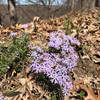Phlox bifida - SAND PHLOX
Beautiful spring perennial with deeply cut pale lila-lavender flowers, south central Indiana genotype.
Forms regular mounds, usually 0.25' tall x 0.5' wide (can be a bit taller or wider too). 2" long linear leaves are everegreen, the base becomes somewhat woody.
Flowers in May and the whole plants is covered with blooms. Full sun, half shade (or dappled shade, if the soil is drier). Drained soils, medium moist to drier, prefers some drainage (sand, gritty soil, rocky soil, poor soils, clayish soil amended with some sand).
Native to central USA and several states of Midwest, where can be found on sand prairies, savannas, limestone glades, along the roads, see the USDA distribution map.
Hardy in zones 4 to 8. Deer can browse on the foliage, especially in the spring, the leaves turn more coarse during the summer.
Flowers are slightly fragrant and are important early source of nectar for butterflies, skippers and moths. Supports other insects too - Darker-spotted Straw and Spotted Straw Moth feed on the flowers and developing seeds (also on other phloxes), Phlox Plant Bug, stem-boring larvae of the long-horned beetle (Oberea flavipes).
This native wildflower is very showy and easy to grow perennial, virtually disease and pest free (doesn't suffer with mildew).
Great for edges of flower borders, woodland edges, rock gardens, pollinator or butterfly gardens. It is slowly spreading plant, but in time can form colonies, mostly by selfseeding.
Picture copyright : US Perennials nursery
Pot size : square 3.5' x 5' deep pot

Phlox bifida - SAND PHLOX
Beautiful spring perennial with deeply cut pale lila-lavender flowers, south central Indiana genotype.
Forms regular mounds, usually 0.25' tall x 0.5' wide (can be a bit taller or wider too). 2" long linear leaves are everegreen, the base becomes somewhat woody.
Flowers in May and the whole plants is covered with blooms. Full sun, half shade (or dappled shade, if the soil is drier). Drained soils, medium moist to drier, prefers some drainage (sand, gritty soil, rocky soil, poor soils, clayish soil amended with some sand).
Native to central USA and several states of Midwest, where can be found on sand prairies, savannas, limestone glades, along the roads, see the USDA distribution map.
Hardy in zones 4 to 8. Deer can browse on the foliage, especially in the spring, the leaves turn more coarse during the summer.
Flowers are slightly fragrant and are important early source of nectar for butterflies, skippers and moths. Supports other insects too - Darker-spotted Straw and Spotted Straw Moth feed on the flowers and developing seeds (also on other phloxes), Phlox Plant Bug, stem-boring larvae of the long-horned beetle (Oberea flavipes).
This native wildflower is very showy and easy to grow perennial, virtually disease and pest free (doesn't suffer with mildew).
Great for edges of flower borders, woodland edges, rock gardens, pollinator or butterfly gardens. It is slowly spreading plant, but in time can form colonies, mostly by selfseeding.
Picture copyright : US Perennials nursery
Pot size : square 3.5' x 5' deep pot


